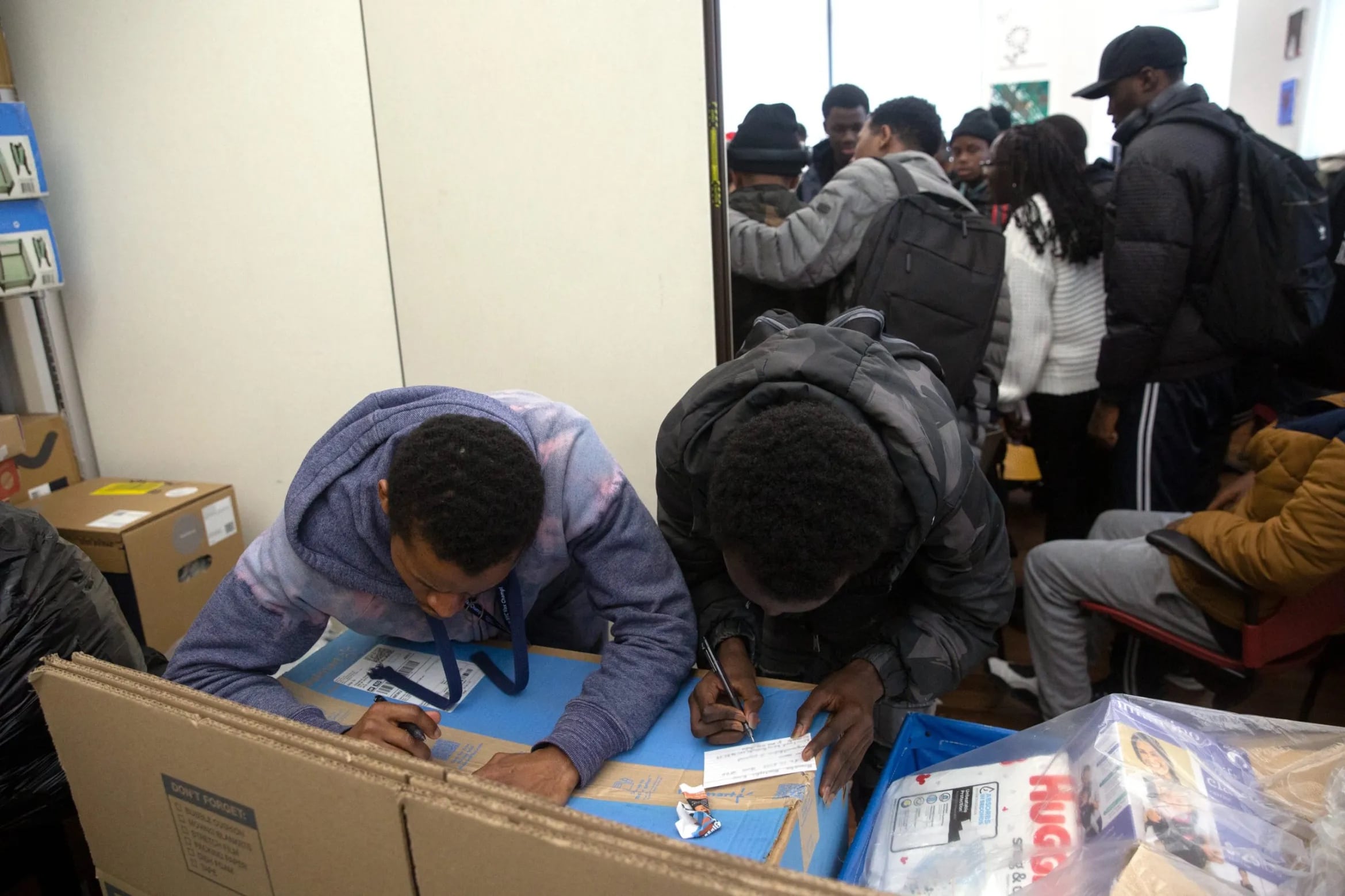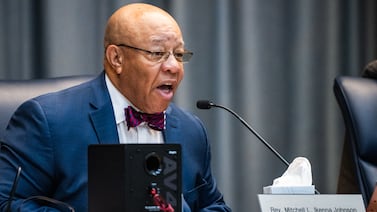This story was originally published on March 12 by THE CITY.
In the depths of January, without a coat on his back, an 18-year-old orphan from Guinea named Mamdou spent a week riding the subways, before a stranger handed him a $20 bill and led him to the Roosevelt Hotel, the city’s main intake for newly arriving migrants. He got a 30-day shelter stint in a converted office tower in Midtown and a few weeks of relative peace after a perilous journey across the world.
But his anxiety built as his eviction day neared. He’d heard about Covenant House, a special youth shelter for people under the age of 21 overseen by the city’s Department of Youth and Community Development, and was determined to secure a bed there.
“I went there every day, sometimes two or three times a day. They know me there,” he said in French on a recent afternoon, two days after he’d been ejected from his Midtown shelter after his 30 days ran out, under Mayor Eric Adams’ strict limits on stays for adult migrants in shelters.
Both nights since his eviction he’d slept outside on the sidewalk. “But every day when I go there they tell me there’s no room.”
The migrant crisis is increasingly intertwined with another crisis: an explosion in the number of homeless youth. Data obtained by THE CITY shows a dramatic increase in young adults between the ages of 16 and 24 reported as having been turned away from specialized shelters that serve young people in that age bracket, with 473 youth rebuffed in the second half of 2023 — up from seven in the first six months of the year.
Last year, DYCD funded about 800 youth shelter beds, with most of those available only to those under age 21, the agency reported to the City Council.
Service providers and advocates had warned for months that the city’s migrant response does not address the needs of the many young people arriving in New York on their own. Those advocates now say the official rejection numbers don’t begin to document just how many young people are unable to find a spot in a homeless youth shelter.
“I’ve been doing this work for 20 years,” said Jamie Powlovich, the director of the Coalition for Homeless Youth, a statewide consortium of more than 60 groups. “I have never seen the level of unmet needs and young people being further traumatized and forced to endure homelessness, especially street homelessness, ever.”
The coalition tallied more than 200 young people turned away from youth shelters in a 12-day period last fall, including seven children under the age of 18, after which they stopped keeping count.
“The list was getting too long, and it wasn’t moving,” Powlovich said. “We didn’t want to add people to a list and give them false hope.”
Advocates have been pressuring the city to make some concessions for youth in the adult migrant shelter system, urging that at the very least adopting the more forgiving 60-day shelter stay limits used for families with children under the age of 18.
“We’ve been told for about four months now that that is something that they’re working on,” Powlovich said. “But it hast happened yet.”
A spokesperson for City Hall didn’t respond to a request for comment, but Mayor Eric Adams has repeatedly defended the city’s handling of the arrival of migrants from the southern border.
“This is a national problem that has been dropped in the lap of places like New York and Chicago, Massachusetts and others who have similar programs, 30‑ and 60‑day programs,” he said at a press conference this week. “We’ve done our job. New Yorkers have done their job, and we’re going to continue to do our job, but this is a national issue.”
While the city’s “right to shelter” court consent decrees are supposed to guarantee a bed that day to anyone who requests one, no legal requirement exists for teens or young adults to be placed in an age-appropriate shelter.
As a surge of teen and young adult migrants arrived last fall, they were funneled into the same tent shelters, converted warehouses and office buildings as other adult migrants without children. The city’s migrant intake centers don’t distinguish migrants in their late teens or early 20s from other adults, and the city doesn’t keep separate data about that age group.
Through the organizing of mutual aid and community groups, some newly arriving migrants have found their way into the specialized youth shelter system, which allows youth to stay longer and offers more specialized support services. But last fall, that system became overwhelmed and securing a bed within it became next to impossible, as reflected in the new city data.
After their 30 days in shelters run out, migrant youth are directed to the East Village “reticketing site” inside an old Catholic school, where they can get in line for another shelter cot, a wait which takes days or weeks. Those seeking new shelter placements are directed to spend nights in outer-borough waiting rooms where they can rest on the ground, but a city survey found that, like Mamdou, hundreds spent the night on the streets or trains instead.
THE CITY reported last month that the city Office of Emergency Management was working on plans to close the “overflow” locations.
‘A human cost’
The city’s eight youth drop-in centers, run by nonprofits, are the formal gateway into the youth shelter system, providing young homeless New Yorkers with clothing, food and showers, and linking them up with case workers who can help connect them with youth shelter beds if they become available. Those centers, too, have seen a sustained spike in usage over the past several months.
In January, 1,600 youth spent time in city drop in centers, a 28% increase from July according to monthly data reported by the city’s Department of Youth and Community Development. Case workers at those drop-in sites served 1,700 people in the first four months of the fiscal year, 300 more than the city had planned to serve in the entire year.
Yet Adams’ preliminary budget released in January proposed slashing $2 million from the $52 million allocated for runaway and homeless youth, eliminating 16 positions that help young people access permanent housing options. The Adams administration is also refusing to implement a recently passed law that would allow people in youth shelters to access CityFHEPS housing vouchers, saying the mandate is too expensive.
Mark Zustovich, a spokesperson for the city’s Department of Youth and Community Development said funding to shelters themselves remained the same in Adams’ proposed budget.
The department and the nonprofits that run shelters for homeless youth “are providing vital services to all youth who seek support — even as the number of young people accessing drop-ins has increased,” he said.
The surge in homeless youth comes a year after a controversial order by the Adams administration banning people from sleeping in 24-hour drop-in centers.
Youth who can’t find shelter are in jeopardy, advocates warn.
“A young woman had recently been discharged from her shelter because her 30 days was up. She didn’t know anybody in the city, spent a night on the street, and was brutally assaulted. That’s preventable,” said Joe Westmacott, a project assistant at Streetwork, which runs a drop-in center for homeless youth in Harlem, referring to an incident that THE CITY has not independently verified.
“We know from decades of research that street homelessness is expensive…. And there’s also a human cost.”
‘They want to go to school’
Many employees at youth facilities are taking the surge in new arrivals in stride, scaling up programs, deftly finding ways to communicate with hand signals in a plethora of languages, and retooling day-to-day operations like how much food they serve on site.
On a busy day before the latest surge in new arrivals, Safe Horizon’s Streetwork daytime drop-in center on 125th Street served about 50 young people a day who would pop in to use computers, eat a meal, peruse the closet of free clothing, or drop off dirty laundry.
Now the center sees about 100 people a day, almost exclusively newly arriving migrant youth who’ve learned about their services through word of mouth. Last fiscal year, the program enrolled 306 new youths into their programs. Four months into this year, they’ve enrolled 542.
Sebastien Vante, associate vice president at Safe Horizon, said they had to halt all new intakes, unable to accommodate any more people. While they can’t connect their clients to specialized youth shelter beds, there are other ways they can support them, he said.
They’ve taken to sending advocates to the East Village reticketing center with their clients, in order to try to advocate for them to get beds in shelters closer to schools if they’re enrolled. They offer referrals to immigration attorneys, and on a recent afternoon, dozens of migrant youth crammed into a back room of the facility intently listening into a demonstration about the asylum application process held in French and Arabic.
“Right now, this is who this is who’s walking through our doors,” Vante said. “Their needs are no different. They’re looking for shelter. They want long-term housing. They want to go to school. They wanna do all these different things.”
But, Vante went on, with its staff already working at capacity, “we spend a significant amount of time managing the expectations of the young people who come into our space,” Vante said.





